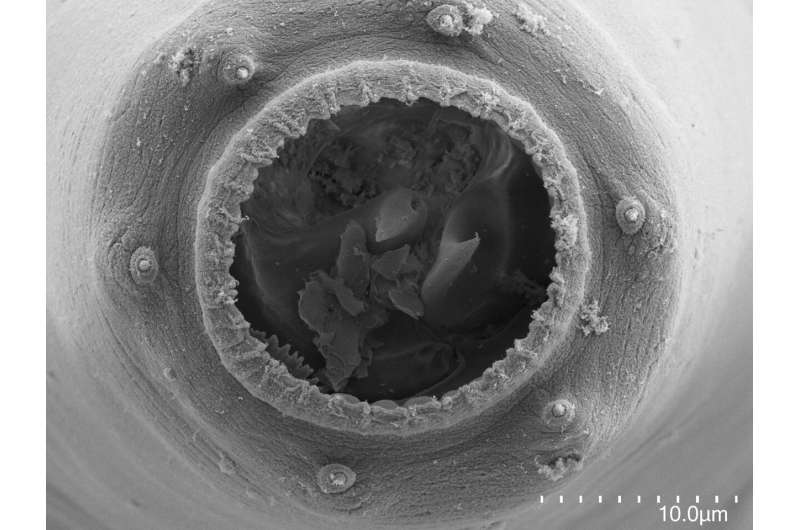This article has been reviewed according to Science X's editorial process and policies. Editors have highlighted the following attributes while ensuring the content's credibility:
fact-checked
peer-reviewed publication
trusted source
proofread
Cannibalism and genome duplication in nematodes

Researchers at the Max Planck Institute for Biology have produced intriguing evidence of how environmental factors and genetic adaptation can lead to the evolution of novel and aggressive traits and behaviors in nematodes.
The discovery of genome duplication and a new cannibalistic morph in Allodiplogaster sudhausi raises questions about how these genetic changes impact social dynamics, intra-species interactions and resource competition within nematode populations. Their findings are reported in Science Advances.
One of the most perplexing mysteries in evolutionary biology is the development of complex traits that often results in morphological diversity. Prof. Dr. Ralf Sommer, Director of the Department of Integrative Evolutionary Biology, has dedicated his life's work to the role of the environment in the development of plasticity and epigenetics.
This research continues to provide evidence of plasticity's profound effect and importance on the morphology, physiological, or behavioral changes in organisms throughout generations.
Nematodes are microscopic roundworms found in the soil. They usually feed on bacteria and are microscopic. Sommer's team researched the nematode Allodiplogaster sudhausi. The new study reveals a surprising twist: These creatures can evolve a giant mouth, develop cannibalistic behavior and they grow twice the size of most soil nematodes.
Stressful and low nutritional conditions induce cannibalism
Prior research on A. sudhausi indicated the presence of two distinct feeding morphotypes that differ in the shape of the mouth and complexity of the teeth. However, Sara Wighard, lead author and former doctoral researcher, identified a surprising third morph.
When fed various fungi, including Penicillium camemberti, the worm developed a gigantic mouth, later called a Terastostomatous (Te) morph. These Te worms were also found under stressful conditions of starvation and crowding. Strikingly, this newly identified morph displayed never-before-seen cannibalistic behavior, where they predate on their own kin despite being genetically identical (these worms are hermaphroditic and don't require males to make offspring).
Sommer explains what could cause them to cannibalize their kin, "They don't receive enough nutrients from the fungi, and along with the resource pressure of being surrounded with so many other worms, they turned more aggressive in response to stress." Outside a lab setting, the cannibalistic behavior would give the species a greater chance of long-term survival in stressful conditions.
Previous findings of Wighard revealed that this species underwent a whole genome duplication (WGD). Unlike their 1-millimeter-long relatives, A. sudhausi grew to 2 millimeters due to WGD, making them visible to the naked eye.
Tracking the novel morph formation
Since the novel trait of a third mouth morph displays no overlap with the other two known morphs, the researchers set out to identify the mechanism regulating the new morph. Using CRISPR, they found conserved developmental switch genes regulates the emergence of this third mouth morph, indicating the co-option of existing genetic mechanisms. Gene dosage studies then revealed the distinct roles of these developmental switches in determining different mouth-forms.
The correlation implies that large-scale genomic alterations like WGD may drive nematodes' morphological novelties and phenotypic diversity. Since no other strain shows similar changes, the team is limited in identifying this phylogenetic resolution until further research is conducted.
Overall, the study sheds light on the complex interplay between environmental factors, in this case, diet and crowding, and genetic changes in shaping morphological diversity. The finding of a new mouth morph with cannibalistic behavior and the WGD event further supports the importance of developmental plasticity in influencing the species' evolutionary path.
This discovery suggests that nematodes can rapidly adapt to harsh environments by developing new traits like cannibalism. The ability to change based on environmental pressures could be crucial to their long-term survival.
More information: Sara Wighard et al, Conserved switch genes that arose via whole-genome duplication regulate a cannibalistic nematode morph, Science Advances (2024). DOI: 10.1126/sciadv.adk6062
Journal information: Science Advances
Provided by Max Planck Society


















